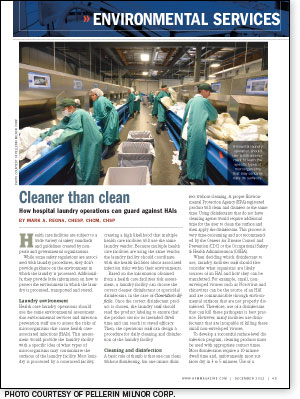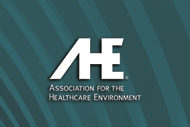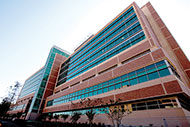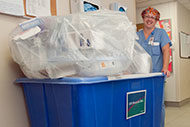 Health care facilities are subject to a wide variety of safety standards and guidelines created by non-profit and governmental organizations.
Health care facilities are subject to a wide variety of safety standards and guidelines created by non-profit and governmental organizations.
While some safety regulations are associated with laundry procedures, they don't provide guidance on the environment in which the laundry is processed. Additionally, they provide little information on how to protect the environment in which the laundry is processed, transported and stored.
Laundry environment
Health care laundry operations should use the same environmental assessment that environmental services and infection prevention staff use to assess the risks of microorganisms that cause health care-associated infections (HAIs). This assessment would provide the laundry facility with a specific idea of what types of microorganisms may contaminate the surfaces of the laundry facility. Most laundry is processed by a contracted facility, creating a high likelihood that multiple health care facilities will use the same laundry vendor. Because multiple health care facilities are using the same vendor, the laundry facility should coordinate with the health facilities about associated infection risks within their environments.
Based on the information obtained from a health care facilities risk assessment, a laundry facility can choose the correct cleaner disinfectant or sporicidal disinfectant, in the case of Clostridium difficile. Once the correct disinfectant product is chosen, the laundry staff should read the product labeling to ensure that the product sits for its intended dwell time and can reach its stated efficacy. Then, the operations staff can design a procedure for daily cleaning and disinfection of the laundry facility.
Cleaning and disinfection
A basic rule of thumb is that one can clean without disinfecting, but one cannot disinfect without cleaning. A proper Environmental Protection Agency (EPA)-registered product will clean and disinfect at the same time. Using disinfectants that do not have cleaning agents would require additional time for the user to clean the surface and then apply the disinfectant. This process is very time-consuming and not recommended by the Centers for Disease Control and Prevention (CDC) or the Occupational Safety & Health Administration (OSHA).
When deciding which disinfectant to use, laundry facilities staff should first consider what organisms are likely sources of an HAI and how they can be transferred. For example, small, non-enveloped viruses such as Norovirus and rhinovirus can be the source of an HAI and are communicable through environmental surfaces that are not properly disinfected. Therefore, use of a disinfectant that can kill these pathogens is best practice. However, many facilities use disinfectants that are incapable of killing these small non-enveloped viruses.
To develop a successful surface-level disinfection program, cleaning products must be used with appropriate contact times. Most disinfectants require a 10-minute dwell time and, unfortunately, most surfaces dry in 3 to 5 minutes. Use of a 10-minute dwell time will require rewetting surfaces to keep the surface wet for the duration of its contact time.
Laundry staff training
Laundry facilities staff should be trained to understand and utilize proper cleaning and disinfecting processes and procedures. For example, to ensure that an area is properly cleaned and disinfected, staff should work clockwise or counter clockwise, top to bottom. When reviewing a laundry facility's process for cleaning, disinfecting and training of staff, the "Five Rs" should be followed: the right staff, right training, right chemicals, right equipment and right time.
Right staff. Laundry facilities professionals should make sure that staff understand the role they play in reducing cross transmission in the laundry facility and are committed to the success of the organization. These two qualities guarantee a positive attitude among the staff who are responsible for daily cleaning and disinfection.
Right training. Laundry facilities professionals should make certain that staff understand the use of all chemicals and equipment. The laundry staff may have the correct attitude toward the required process to maintain the facility, but if they have not received the right training, there will be EPA-compliance issues.
Right chemical and right equipment. Ensure that the right EPA-registered hospital disinfectant is in place and the correct cleaning products meet the Emergency Planning and Community Right-to-Know Act requirements. Continually using the same products assists in standardization of training and risk management, as well as coinciding with EPA and OSHA guidelines. Lastly, laundry facilities professionals should make certain that all areas used for storing chemicals and equipment are well-maintained. This will help keep cleaning equipment from becoming a mode of cross-transmission to other areas.
Right time. The previous four steps will lead to the right time. Following the schedule of allotted time to ensure proper surface disinfection is crucial for maintaining product efficacy.
Scheduling issues
Laundry facilities should design cleaning and disinfection schedules that serve as an overview of how the laundry is maintained on a daily, weekly and monthly schedule. Cleaning and disinfection procedures should cover the following:
Daily cleaning and disinfection of all stationary and portable equipment. Using an EPA-registered cleaner disinfectant or a sporicidal disinfectant is key to reducing microbes that cause HAIs. In some cases, cleaning and disinfecting equipment may be required several times per day depending on the soil and bioload of the textiles being processed in the laundry facility.
Daily cleaning and disinfection of all horizontal surfaces. This plays an important role in reducing cross-transmission from hand contact and contact from textiles moving from surface to surface. Special attention is needed for high-touch surfaces. This may require staff to clean and disinfect throughout the day.
Daily cleaning and disinfection of all hard floor surfaces. As part of the daily environmental cleaning and disinfection, staff should use proper cleaner disinfectants on hard floors to reduce the soil and bioload to a safe level.
Daily cleaning and disinfection of all restrooms. Restrooms are key for the laundry staff's safety and hygiene. Properly cleaned and disinfected restrooms will lessen the chance of staff absenteeism due to illness.
Daily cleaning and disinfection of all common areas. The likelihood of cross-transmission from contaminated work surfaces to such common areas as break rooms, offices and hallways is high. These areas should be cleaned and disinfected with the same products used in the laundry processing areas to ensure a safe environment for all facilities staff.
Weekly terminal cleaning and disinfection of walls and ceilings. Laundry facilities should schedule weekly wall and ceiling cleaning and disinfection to provide a clean, safe environment and to reduce the possibility of soil and bioload cross-transmission to other surfaces or to hands.
Keeping it clean
A proper cleaning and disinfection program will help health care laundry facilities protect their staff members and the textiles they are processing.
Given the threat of HAIs and the costs associated with them, those who provide services to health care organizations need to do their part in providing a safe health care environment.
Mark A. Regna CHESP, CHCM, CHSP, is vice president of sales and marketing at BioMed Protect LLC, Earth City, Mo. He can be reached at mregna@biomedprotect.com.
| Sidebar - Resources on the Web |
| Several resources on safe health care laundry operations are available on the Web. They include:
|





